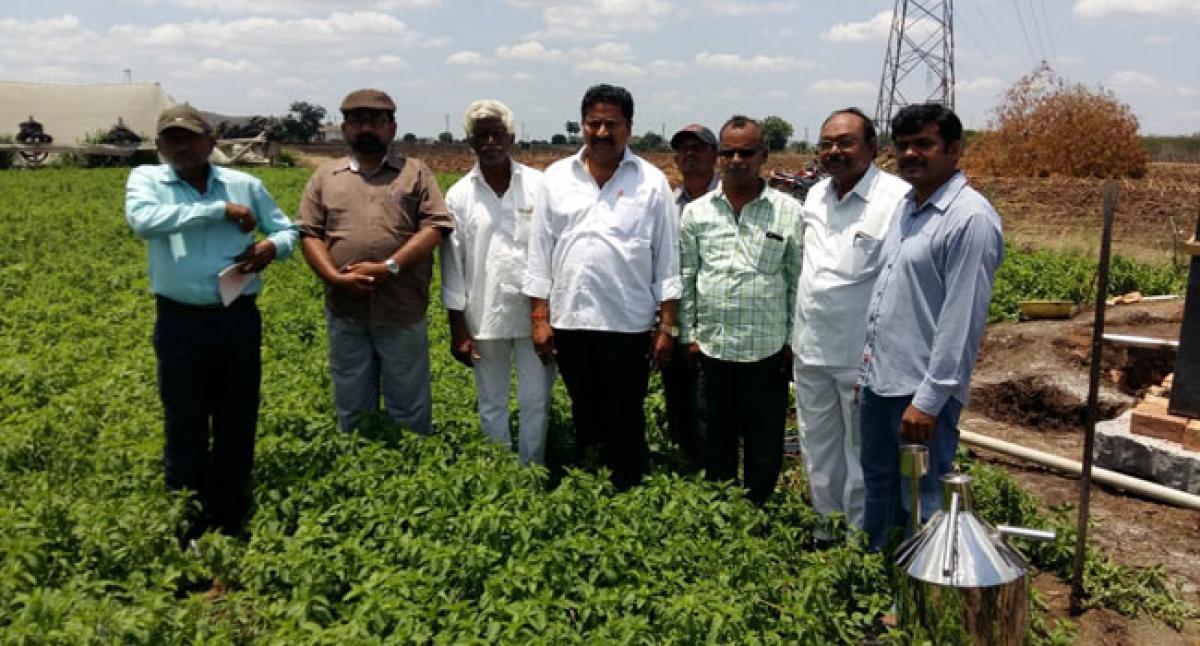Live
- UpStudy: The Smart Solution for Homework Hassles
- Actress Rithika and models inaugurate Sutraa Lifestyle Exhibition
- Loud campaign
- Faculty students celebrated english literature day in Government Degree College
- Huge fire accident.. Shops of street vendors burnt in the fire
- Pawan Kalyan promises to protect the coastal area from sea erosion
- EC Transfers Two Senior IPS Officers in AP ahead of Elections
- DMK analysis predicts victory for INDIA bloc in TN but concedes gains for BJP and NDA too
- India showcasing innovative technologies at World Energy Congress
- IPL 2024: Mitchell comes in for Ravindra as Lucknow opt to bowl first against Chennai
Just In

The cultivation of aromatic plants is expected to provide a promising future to the farmers in the droughthit district of Prakasam With the initiative of the officials, 15 farmers from Prakasam and Guntur districts have started cultivation of Japanese mint as a pilot project and the results proved highly encouraging
Ongole: The cultivation of aromatic plants is expected to provide a promising future to the farmers in the drought-hit district of Prakasam. With the initiative of the officials, 15 farmers from Prakasam and Guntur districts have started cultivation of Japanese mint as a pilot project and the results proved highly encouraging.
The officials say they are ready to introduce other varieties of aromatic plants and are encouraging the farmers from western area of the district to cultivate them instead of the regular crops to save themselves from the losses.
The Japanese mint (Mentha arvensis) is an aromatic plant and the oil extracted from it is used in cosmetics, pharmaceutical preparations, relaxation therapies and aroma oils. Farmers in Uttar Pradesh cultivate Japanese mint in four lakh acre every year, with Barabanki district alone cultivating the crop in 2.5 lakh acre.
After suffering losses continuously due to drought and bad weather conditions, the farmers in Prakasam district wanted to shift from the regular crops. Then the officials in the Spices Board and Horticulture department formed a team of 15 farmers and sent them to Barabanki for an exposure visit and training in cultivation of Japanese mint.
After returning from the tour, 10 farmers began farming the mint in their area. Danda Veeranjaneyulu, member of the Spices Board Advisory Committee, also cultivated the Japanese mint in his farm at Bobbepalli in Martur mandal. Veeranjaneyulu said that they brought the seed of the mint and prepared the saplings like they do for chillis and paddy, and transplanted them in a 12-square inch pit and removed the weed.
After 90 days, when the flowering stage started, leaves are cut and oil is extracted through distillation process. He said that he spent around Rs 35,000 per acre and received about 60 kg oil that costs about Rs 1 lakh. He said that many farmers are visiting his farm regularly and more than 1,000 farmers from the Prakasam and Guntur districts have shown interest in the cultivation of mint.
The Horticulture department is taking steps to provide subsidies for seed and distillation units. M Hari Prasad, assistant director of horticulture in the district, said that the Japanese mint can also be cultivated in drip irrigation method by the farmers from the western area in the district.
He said that they were trying to form Farm Producers Organisation to make sure that the produce is marketed in time and help the farmers to get more subsidies. He said that they would gradually introduce citronella, palmarosa and other plants to the farmers so that they can make use of these cash crops which have global market.

© 2024 Hyderabad Media House Limited/The Hans India. All rights reserved. Powered by hocalwire.com







